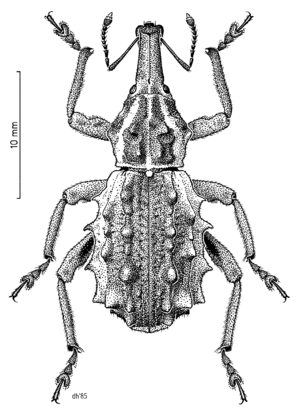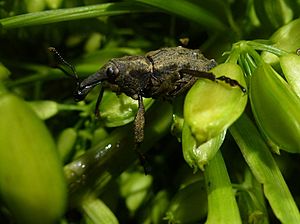Coxella weevil facts for kids
Quick facts for kids Coxella weevil |
|
|---|---|
 |
|
| Hadramphus spinipennis illustrated by Des Helmore | |
| Conservation status | |
 Nationally Vulnerable (NZ TCS) |
|
| Scientific classification | |
| Genus: |
Hadramphus
|
| Species: |
spinipennis
|
The Hadramphus spinipennis, also known as the coxella weevil, is a large and interesting insect. It is a type of weevil, which is a kind of beetle. This weevil is special because it is active at night (nocturnal) and cannot fly (flightless). You can only find it on Mangere and Rangatira Islands, which are part of the Chatham Islands in New Zealand.
Contents
About the Coxella Weevil
What Does It Look Like?
The coxella weevil has a brown body shaped like an egg. Its antennae are shiny and brownish-black. It has noticeable bumps, called tubercles, on its sides and on its belly. The underside of the weevil is black.
Adult weevils are usually about 21–22 mm long, not counting their snout (rostrum). Female weevils can grow a bit bigger, up to 25 mm long. They are about 10 mm wide. This makes them the only large weevil found on the Chatham Islands.
Where Was It Found?
The coxella weevil was first described by a scientist named Thomas Broun. It was discovered by Thomas Hall, who worked with sheep on Pitt Island in the Chathams. He collected many new insect species for Broun to study.
Even though it was first found on Pitt Island, the weevil hasn't been seen there since. This is probably because its main food plant was almost completely eaten by sheep. The coxella weevil is one of four Hadramphus weevil species. All of them are unique to New Zealand, cannot fly, and are quite rare.
Weevil Life and Habitat
What Do They Eat?
The coxella weevil mainly eats a plant called Aciphylla dieffenbachii, also known as coxella or Dieffenbach's speargrass. This plant is a softer cousin of the spiky Aciphylla plants found on New Zealand's mainland.
Adult weevils make special oval-shaped bites on the plant's leaf stems. Sometimes, they scrape the leaf to make the plant produce a sticky gum. They enjoy eating the green seeds and flowers of the coxella plant, especially the male flowers.
Weevil larvae (young weevils) also feed on the plant. They can glue leaves together to create a safe place to eat. Larvae also feed inside the plant's crown, near the base of the leaves. If too many larvae are present, they can even kill the plant!
How Do They Move Around?
Because weevils can sometimes kill their food plants, adult weevils can walk long distances. They can travel up to 600 meters to find new patches of coxella plants. It seems they rely on new patches of Aciphylla growing after older ones are destroyed by too many weevils.
Coxella weevils are also sometimes found on Chatham Island lancewood (Pseudopanax chathamicum). They seem to use these plants for shelter but only eat them occasionally.
Life Cycle of the Coxella Weevil
Adult weevils like to gather together in groups. You can often see them on coxella flower heads on warm, humid nights. They mate between September and March, usually on the male flowers.
After mating, the female weevil buries single eggs in the soil under the host plant. This happens from September to April or May. The larvae grow by eating the plant's roots. They then turn into adult weevils in special chambers up to 600 mm deep in the soil. Adult coxella weevils can live anywhere from a few months to four years.
Protecting the Coxella Weevil
This weevil is only found on the two small islands of Mangere and Rangatira. These islands are free of predators that might harm the weevils. It's possible they might also live on other small rocky areas that have coxella plants.
The weevil's main food plant, A. dieffenbachii, is also rare. It grows mostly on Mangere Island, with some on Rangatira, and in parts of Pitt and the main Chatham Island where farm animals haven't eaten it.
Because the coxella weevil lives in such a small area and depends on only one type of plant, the Department of Conservation has classified it as Nationally Vulnerable. This means it's at risk. To help protect the weevil, scientists hope to create a third population. This would involve planting Aciphylla in an area free of farm animals and, ideally, without cats, mice, or weka (a type of bird that could eat them).


